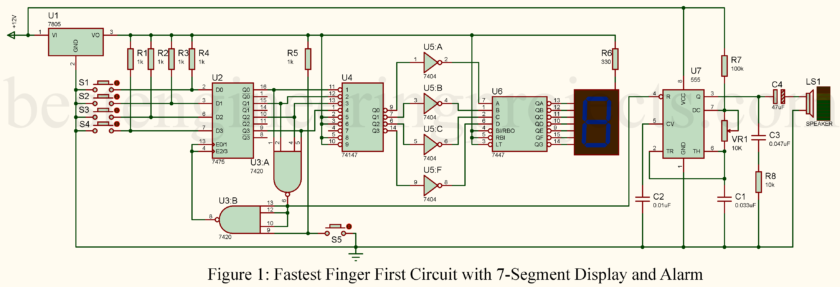Imagine you’re on stage, heart pounding, eyes locked on the big screen in front of you. The host asks the final question—this is it. Your reflexes are sharp, your hand hovers over the buzzer, and then BAM! You slam that button down faster than a cheetah chasing its dinner. But how does the system know you were the first? That’s where the Fastest Finger First Circuit steps in.
This little piece of engineering magic can make or break a game show, quiz night, or classroom competition. Today, we’re diving into how this circuit works, how it locks in the first button press, and what makes it so darn cool.
What Is the Fastest Finger First Circuit?
At its heart, this circuit is a referee. It doesn’t play favorites, it just wants fairness. As soon as someone presses their button, the system locks out every other contestant. Simple? Absolutely. Effective? You bet.
The 7-segment display shows who pressed their button first. The audio alarm chimes in to celebrate the fastest player—like a tiny round of applause in electronic form. The real magic? It all happens in a split second, faster than you can say, “Oops, I was too slow!”
Breaking Down the Circuit (No Overload, Promise)
Let’s unpack this masterpiece. Every component plays its role like a perfectly choreographed dance. Let’s meet the cast:
- Switches (S1-S4): These are the contestants’ lifelines. Press one, and the circuit wakes up. Think of them as the “buzzer buttons.”
- 7475 – Latch IC: Ever see a picture freeze the moment in time? Well, that’s what this IC does. It latches on to the first button press, and it says, “This is it.
- 74147 Priority Encoder: Well, here is where it gets pretty nerdy. It takes that button press and converts it into some sort of digital language the display can understand. Translating excitement to binary.
- 7-Segment Display Driver (7447): Once the priority encoder has done its job, this IC lights up the correct number on the display. Imagine it like a tiny, obedient scoreboard operator.
- 555 Timer Alarm: No winner is complete without fanfare. The 555 timer creates a sound—beep, buzz, or whatever you want—to celebrate the fastest finger.
How It All Comes Together
Picture this: Four players. Four buttons. The game host gives the go-ahead, and in the blink of an eye, someone hits their button. The latch IC snatches the signal, the encoder interprets it, the display lights up, and the alarm is heard. It is like the electric circuit exclaiming, “We have a winner!
And the best part? The system locks everyone else out. It’s fair. It’s fast. It’s flawless.
Why This Circuit is a Must-Have
You might be thinking, “Okay, but why do I need this?” If you’ve ever run a game or quiz night, you know how chaotic things can get. Everyone claims they hit the button first. Arguments break out. The fun disappears faster than snacks at a party. This circuit solves all that.
It’s not just for games, either. Schools, team-building exercises, even family game nights—this circuit brings clarity and fun wherever it goes. It’s like having a fair referee who never gets tired.
Make It Yours (Customisation is Key)
Want to make it personal? Add more players. This design can easily be expanded to include more contestants. Change the sound of the alarm—make it play a little tune if you’re feeling fancy. The possibilities are endless when you let your imagination run.
A Quick Note on Building It
A Quick Note on Building It
Just remember before reaching for that soldering iron: patience. The circuit isn’t in the least complex, but every wire, every connection, and every component counts. One little mistake, and you might find yourself working with an inanimate piece of silent plastic. Take it slow; double-check your work. And if it doesn’t work-well, that’s happened to the best of them.
Closing Thoughts
The Fastest Finger First Circuit is way more than wires and chips; to any kind of person who enjoys a little friendly competition, it’s literally going to change the game. Be it quiz night, running an activity at your classroom, or simply looking to have some fun, this circuit is your perfect sidekick.
What are you waiting for? Fire up your multimeter, unleash the mad scientist inside you, and bring this circuit to life. Next time someone asks, “Who was first?” you will know the answer-and it is loud, clear, and oh-so-satisfying.

Fascinating! Not very complicated & well described.
V Gd circuit, but this should have been provided for an average of atleast 12 or 15 players or so, as the present setup r4 players is far too short and